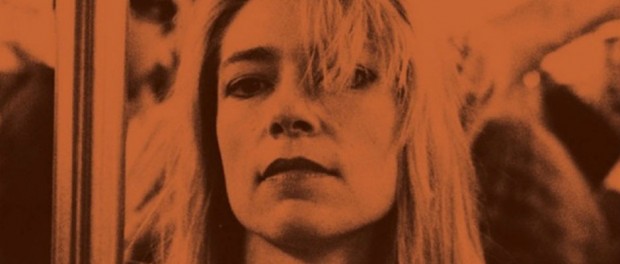Kim Gordon – Girl In A Band
It's not a memoir or a music book, so what is 'Girl In A Band'?
 Kim Gordon
Kim Gordon
Nevermind, what was it anyway?
I wanted to let the buzz of publisher-initiated PR coverage fade before settling down and reading Kim Gordon’s Girl in a Band. The author bio inside the back cover describes her as a musician, vocalist, actress, writer and I reminded myself she’s also an artist, clothing design and mother too. I’ve loved her work for some twenty years. I was intrigued to add this memoir to my knowledge of her writing gleaned from the collections Dissonatine and Is it My Body. Gordon has really earned her reputation as one kick-ass creative individual.
But on closing the book I felt sad. The back cover blurb had stated that a shy and sensitive soul lives beneath the exterior cool of Gordon’s stage persona, but the book kept that interior safely hidden and out of reach. The first hundred pages whip by in a blizzard of description with barely a whisper of emotion. Her father dies of Parkinson’s disease and we learn of the changes to living arrangements necessary for his care. Her brother’s mental illness is touched upon — she suggests his bullying as a critical component in forging her personality — but the manifestations of his issues are sparingly sketched and we never learn of the drip-drop injuries committed to her psyche. The book’s opens by describing the icy atmosphere at Sonic Youth’s final show, making clear that even when surrounded by people she presumably knew and could count as friends, most of her energy was given over to not speaking, to staying away from situations where she might be asked to expose herself. Given that was how she felt around friends it’s understandable why we, the distant audience, are never going to be permitted honest emotion in her book.
Page after page is taken up in a flood of name-dropping and Twitter-length descriptions of other people’s genius. It feels like another manifestation of Gordon’s shyness. In a world of autobiographies rendered unreadable by the author’s narcissistic self-regard it is, at first, wonderful to see someone so generous that she devotes her memoir to cataloguing those who have bestowed kindness upon her. But really what we’re witnessing is Gordon hiding herself amid a forest of others. Meanwhile it underlines that Gordon claims little credit for her own success. There’s scant pride on display, she talks of other’s achievements while neutral toward and barely able to speak of her own.
Support the Flower of Women
Girl in a Band is a disturbing read that has the breakdown of Gordon’s marriage to Thurston Moore at its core. Their band, Sonic Youth, gained godhead status over a thirty year career while the couple came to possess a talismanic quality, giving hope that romance could survive the rigours of the rock world and a creative life intact. Writing as a therapeutic practice isn’t uncommon but in this case there’s a voyeuristic air. Gordon’s obvious pain and the aftermath of marital breakup is churned by a major publisher as best-selling product for public consumption in exchange for cash.
Further discomfort is created because one can’t help but question the motives behind this very public worldwide airing of dirty laundry. If Moore, instead of maintaining his steadfast silence regarding the end of the marriage (which, being fair, he ended by pursuing a relationship with someone else), had chosen to launch such an assault on Gordon would the commentariat still be so keen? Or would it have become another indication — alongside revenge porn and other humiliations wounded idiots bestow on ex’s — of the emotional humiliations men wreak upon women?
There’s a question mark over what this book is for. Girl in a Band isn’t a memoir, it isn’t a review of a life lived. It also quite clearly isn’t a music book. It is so focused on asking what went wrong in Gordon and Moore’s marriage that Sonic Youth is treated dismissively, perhaps even spitefully, and deliberately so. In the middle third of the book there’s a rapid-fire of unrevealing anecdotes covering a smattering of the band’s songs. Being generous, it feels like a reaction to current pain with Gordon barely able to speak of the other institution she and Moore forged together.
The hazy absence of emotion, the same vibe that courses through her pre-SY memories, reduces the career of one of the greatest American bands to a lazy shoulder-shrug. She only livens up when talking of another famous friend – Kurt Cobain. When Cobain’s Journals were released and hand-wringing about the ethics of reading them had passed, what remained was a set of semi-juvenile sketches, banal band-business notes and sophomoric opinions. We learnt that Cobain took to music because that was how he could truly express himself. There’s a similar vibe from Girl in a Band of someone who played music to unleash pent-up howling that just can’t emerge on a page. Contemplate Gordon’s song, ‘Shadow of a Doubt’; in a sparsely-worded whirl of emotion bodies crash together in a rattling train, first sight turns to passionate infatuation then dissolves into dreams woken in a jostled carriage. Now read this book. Gordon founds Sonic Youth. Yes, but how does it feel Kim? They release a record. Yes, but what did it mean to you Kim…?
Reading the book seems like prying into someone’s conversations with a therapist. There’s a narcotized air to these memories: reportage of scenery, events, thoughts — made void by an inability to express any resulting feelings. Recalling the budding early days with Moore, Gordon muses, “I wonder whether you can truly love, or be loved back, by someone who hides who they are?” It’s unclear if the comment is deliberately, or only ironically, self-referencing. The line further suggests an utter inability, in light of recent betrayal, to even look back and acknowledge that she and her husband were ever in love.
Use the word ‘fuck’
Gordon emerges as a traumatized and wounded figure. Men dominate the story: father, brother, boyfriends, lovers. Her emotional inarticulacy means we see her vivisecting her life, circling back to male relationships, yet always ending up with conclusions that suggest she blames herself for the fate of her marriage. This book feels like it should be covered by patient confidentiality. The duality on display — frozen surface and attempted suppression speaking volumes of the roiling interior — belongs more to psychiatry and to talking cures.
Gordon recalls being teased for being ‘middle class’ when she first arrives in post-punk New York. She states it’s because of how she dressed. I’d suggest it’s most screamingly visible in her inability to be uncouth. She can’t bring herself to unashamedly yell “fuck you!” at the guys who have hurt her or to give them the blame they deserve. It’s frustrating. I wanted Gordon to give people the middle digit — she’s entitled to. Owning one’s anger, knowing that sometimes it is the legitimate reaction, that’s maturity. Instead my sympathy was nullified by the pretense of poise in which she attempts to stand on the aloof high ground while sniping and tossing in barbed remarks. It’s a lie, and very middle class one at that.
Bile is reserved, instead, for Courtney Love and for Moore’s current partner. Love is criticized, it seems, because Moore’s enjoyment of her dark energy foreshadows what Gordon sees in ‘the other woman.’ It leaves a sour taste that an individual held up as a feminist icon spits more poison at two women than at any man but maybe that’s equality. More disturbingly, each is reduced to the stereotyped ‘devil woman’; sexual predators using men to advance. It’s a deeply regressive reading of female agency which simultaneously reduces Cobain and Moore to gawping boys with minimal responsibility for their actions.
Having indicated that the most important thing about these two women is the men they wind up with and how they get them, the book’s concluding pages aim for some kind of resolution in Gordon’s decision to reject a man’s advances. While appearing to strive for some self-actualizing moment of power and renewal it instead comes across as a declaration that her continued sexual attractiveness is what matters most. It reinforces a strong current in which Gordon’s life seems to be granted fulfillment only through men’s attention and approval. I’m left wondering if Girl in a Band is a deliberate attempt to undermine her own icon status by placing male dominance of female being center-stage. Is this all a knowing parody?
Use the power of
If this was an average person’s cry of pain it never would have been published. Unable to describe her feelings Gordon fills pages with insignificant background detail: interior décor, piled-up shirts, a liking for good stucco. Sometimes the lists of people she’s met topple into one another so rapidly the events of her life feel squashed. It’s a tragedy. Gordon’s work has meant a lot to me and I wish a good editor had been involved to protect her from exposing so much and so little all at once. Buried here is a life seized by the throat; a worthy, impressive and fascinating life. A good editor would have coaxed Gordon beyond her state of shock to add flesh to these bare-bone remembrances. To respect and credit Gordon’s life.
One of the book’s central conceits is that Gordon claims “what’s it like to be the girl in a band?” is the most irrelevant question she’s asked by journalists. She discounts it, claiming she never thought about her role in the band via gender… in a book that foregrounds sexual partnering as the most critical thing she wants to write about. There was so much she could have usefully contributed to the discussion of how female creativity is used and presented.
Instead, we get a book that indulges in what feels like ‘slut shaming’ and doesn’t even feel like talking about Gordon’s immense creativity because we need to talk about boys instead. What Gordon describes as a public persona seems to be armour she developed as a child to protect herself from pain. In order that she would never accidentally steal the spotlight her tormentor — her brother — demanded be reserved for himself, Gordon buried her emotional experience of the world deep inside. Intellectualization allowed her to tell her life story with camera-like objectivity but divorced from feeling. Art, by letting her adopt a persona to be performed, let her imitate and act out the feelings she couldn’t express in day-to-day life. This book is a poor vehicle for Gordon because throughout its clear we’re listening to the invulnerable surface while the real woman is hidden, safe and protected.
The word is love
This frustration and sadness does not mean that the book is devoid of pleasures. They come via Gordon’s eye for lyrical detail. The book is best if you simply luxuriate in the flicker of fast-moving images of time and place — it’s like watching scenery through the window of a train. Similarly, when she shifts to intellectual contemplation she’s visibly more comfortable and makes some well-spoken points. She also weaves effortlessly between formats, melding together media quotation, comments from friends, her memories, lyrics, whatever makes her point, in an effective montage that supports the book’s momentum. She’s a good writer.
What Gordon isn’t, however, is a woman who, at the time of writing Girl in a Band, had come to terms with a loss, or who felt able to talk honestly about her life. The book is a constant digression; a facing away from the things of which she speaks and that her gaze can’t help but return to. I’d like to see pride in her words, a women proud of all she’s accomplished – electrified rapture, strength as hard as raw feedback. But all I see is stunned silence. An absence.





